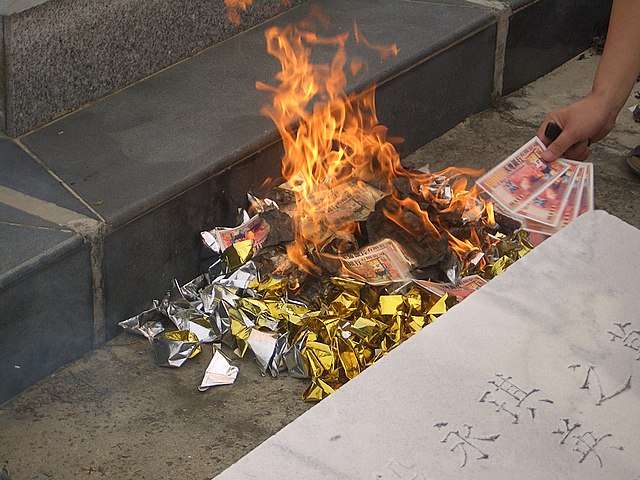The veneration of the dead, including one's ancestors, is based on love and respect for the deceased. In some cultures, it is related to beliefs that the dead have a continued existence, and may possess the ability to influence the fortune of the living. Some groups venerate their direct, familial ancestors. Certain religious groups, in particular the Eastern Orthodox Churches, Catholic Church and Anglican Church venerate saints as intercessors with God; the latter also believes in prayer for departed souls in Purgatory. Other religious groups, however, consider veneration of the dead to be idolatry and a sin.
Famadihana reburial ceremony
Burning of incense during a veneration at Mengjia Longshan Temple, which is dedicated to Guan Yu, Mazu, and others
Burning offerings
Śrāddha taking place at the Jagannath Ghat in Calcutta, at the end of Pitru Paksha.
The afterlife or life after death is a purported existence in which the essential part of an individual's stream of consciousness or identity continues to exist after the death of their physical body. The surviving essential aspect varies between belief systems; it may be some partial element, or the entire soul or spirit, which carries with it one's personal identity.
A depiction of Idris visiting Heaven and Hell from an illuminated manuscript version of the Islamic text Stories of the Prophets (1577)
Georgin François, The 3 Roads to Eternity, 1825.
Judgment of the Dead in Duat
This detail scene from the Papyrus of Hunefer (ca. 1375 B.C.) shows Hunefer's heart being weighed on the scale of Maat against the feather of truth, by the jackal-headed Anubis. The ibis-headed Thoth, scribe of the gods, records the result. If his heart is lighter than the feather, Hunefer is allowed to pass into the afterlife. If not, he is eaten by the waiting Ammit. Vignettes such as these were a common illustration in Egyptian books of the dead.








